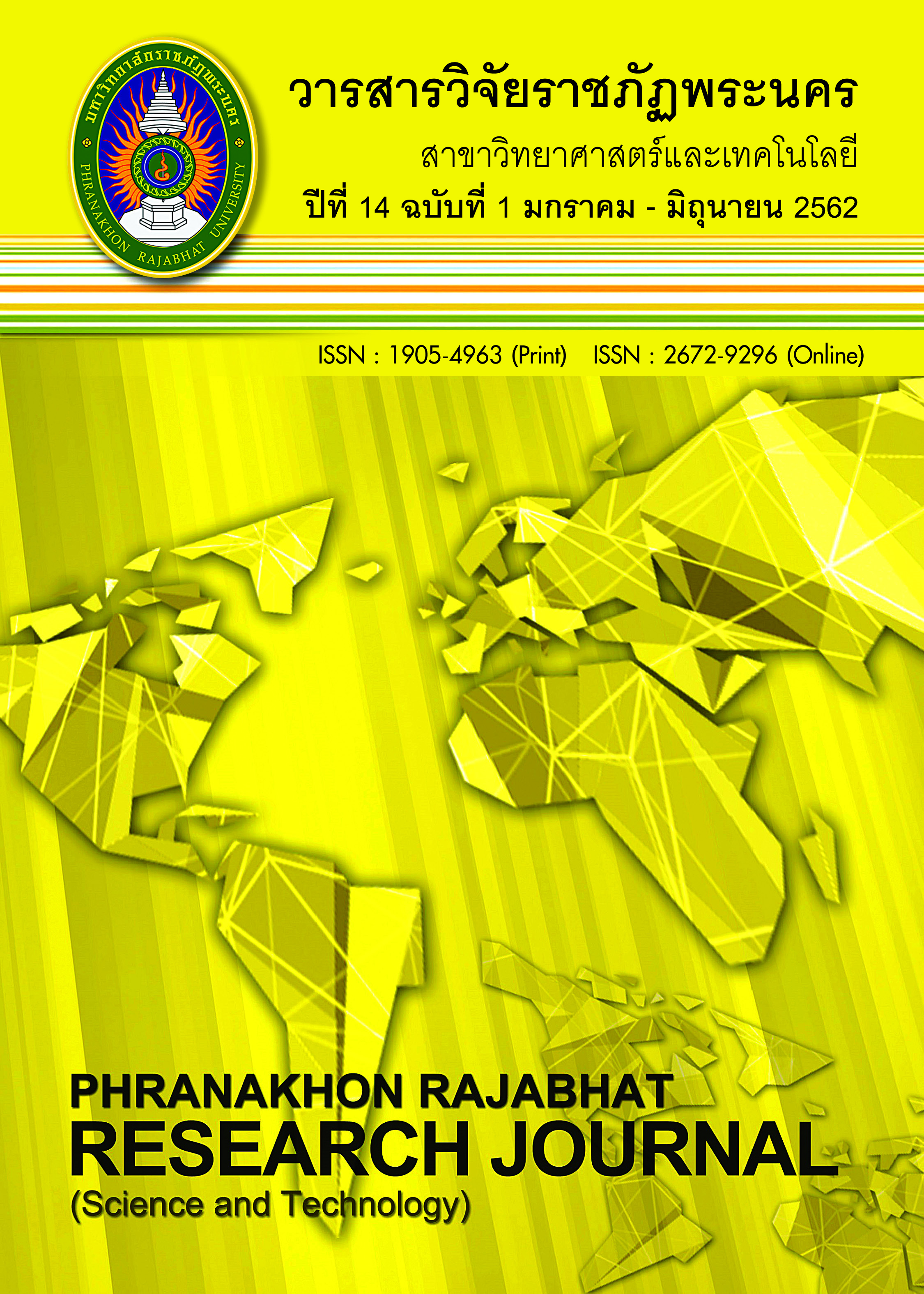การเตรียมน้ำแช่ข้าวไรซ์เบอร์รี่และการประยุกต์ใช้ในผลิตภัณฑ์วุ้นกะทิ
คำสำคัญ:
ข้าวไรซ์เบอร์รี่, วุ้นกะทิ, สารต้านอนุมูลอิสระบทคัดย่อ
งานวิจัยนี้มีวัตถุประสงค์เพื่อศึกษาสภาวะของการสกัดน้ำข้าวไรซ์เบอร์รี่ที่เหมาะสมในการผลิตวุ้นกะทิ โดยคัดเลือกวุ้นกะทิสูตรพื้นฐานจำนวน 3 สูตร พบว่า วุ้นกะทิสูตรที่ 1 มีคะแนนเฉลี่ยการยอมรับสูงสุด (p<0.05) จึงเลือกวุ้นกะทิสูตรที่ 1 จากนั้นศึกษาสภาวะของการสกัดน้ำข้าวไรซ์เบอร์รี่ในอัตราส่วนน้ำต่อข้าวไรซ์เบอร์รี่เท่ากับ 2:1 (w/w) และผันแปรระยะเวลาในการสกัดเป็น 3 ระยะ คือ 30 45 และ 60 นาที พบว่า วุ้นกะทิที่ใช้น้ำข้าวไรซ์เบอร์รี่สกัดที่ระยะเวลา 45 และ 60 นาที มีคะแนนเฉลี่ยการยอมรับในทุกด้านไม่แตกต่างกัน (p>0.05) จึงคัดเลือกวุ้นกะทิที่ใช้น้ำข้าวไรซ์เบอร์รี่สกัดที่เวลา 45 นาที ไปวิเคราะห์คุณลักษณะทางเคมี-กายภาพ พบว่า ค่าความสว่าง (L*) มีค่าลดลง (p<0.05) ส่วนค่าสีแดง (a*) ค่าสีเหลือง (b*) และ ความแข็งของเจล (Gel strength) มีแนวโน้มเพิ่มขึ้น (p<0.05) วุ้นกะทิที่ใช้น้ำข้าวไรซ์เบอร์รี่สกัดที่เวลา 45 นาที มีปริมาณสารประกอบฟีนอลิกทั้งหมดและปริมาณสารแอนโธไซยานินทั้งหมดเท่ากับ 58.76 mgGAE/g และ 5.87 mg/100 g ตามลำดับ ประสิทธิภาพการต้านอนุมูลอิสระเมื่อวัดด้วยวิธี DPPH และ ABTS โดยมีค่า IC50 เท่ากับ 46.81 และ 47.39 mg/mL ตามลำดับ
เอกสารอ้างอิง
Bainak, J., Wongpakdee, R. & Suksomboon, A. (2015) Development of Dried Rice Noodle (Kanom-geen) from Riceberry. Agricultural Science Journal. 46(3), 361-364. (in Thai)
Chaisuwan, S. (2012). Coconut milk jelly formula. Retrieved November 8, 2012, from https://www.baanpimwun.com. (in Thai)
Choi, Y., Lee, S.M., Chun, J., Lee H.B. & Lee, J. (2006). Influence of heat treatment on the antioxidant activities and polyphenolic compounds of shiitake (Lentinus edodes) mushroom. Food Chemistry. 99, 381-387.
Dai, B. & Matsukawa, S. (2012). NMR studies of the gelation mechanism and molecular dynamics in agar solutions. Food Hydrocolloids. 26, 181-186.
Finocchiaro, F., Ferrari, B. & Gianinetti, A. (2010). A study of biodiversity of flavonoid content in the rice caryopsis evidencing simultaneous accumulation ofanthocyanins and proanthocyanidins in a blackgrained genotype. Cereal
Science. 5, 28-34.
Hossain, S.J., Tsujiyama, I., Takasugi, M., Islam, M.A., Biswas, R.S. & Aoshima, H. (2008). Total phenolic content, antioxidative, anti-amylase, anti-glucosidase, and antihistamine release activities of Bangladeshi fruits. Food Science and Technology Research, 14(3), 261-268.
Ko, F.N., Cheng, Z.J., Lin, C.N. & Teng, C.M. (1998). Scavenger and antioxidant properties of prenylflavones isolated from Artocarpus heterophyllus. Free Radical Biology and Medicine. 25(2), 160-168
Leardkamolkarn, V., Thongthep, P., Suttiarporn, R., Kongkachuichai, S., Wongpornchai, S. & Wanavijitr, A. (2011). Chemopreventive properties of the bran extracted from a newly-developed Thai rice The Riceberry. Food Chemistry, 125, 978-85.
Oki, T., Masuda, V., Kobayash, V., Nishiba, V., Furuta, V., Suda, I. & Sato, T. (2002). Polymeric procyanidinsas radical-scavenging components in red-hulled rice. Journal of Agricultural and Food Chemistry, 50, 7524-7529.
Pattaneeya, P., Reuthaithip, S., Rin, C., Vijitra, L., Surat, K., Uruwan, Y., Apichart, V. & Ratchanee, K. (2013). Amelioration of hyperglycemia, hyperlipidimia, oxidative stress and inflammation in steptozotocin-induced diabetic rats
fed a high fat diet by riceberry supplement. Journal of Functional Foods. 5, 195-203.
Podjanalekha, P., Saenmuan, S., & Phothiset, S. (2018). Effect of temperatures on physicochemical properties of Riceberry flour. Khon Kaen Agriculture Journal, 46, 212-217. (in Thai)
Ramadhan, R. & Phuwapraisirisan, P. (2015). Arylalkanones from Horsfieldia macrobotrys are effective antidiabetic agents achieved by alpha-glucosidase inhibition and radical scavenging. Natural product communications. 10(2),
325-328.
Somboon, N. (2013). Properties of Agar and Fish Gelatin Mixed Gels. M.Sc. Program in Food Science and Nutrition. Faculty of Science and Technology, Prince of Songkhla University. (in Thai)
Tasiri, P., Suttisansanee, U., Hudthagosol, C. & Somboonpanyakul, P. (2015). Development of Riceberry Rice Vegan Jelly Contains High Protein and High Energy for the Elderly with Dysphagia. Agricultural Science Journal. 46(3),
369-372. (in Thai)
ดาวน์โหลด
เผยแพร่แล้ว
ฉบับ
ประเภทบทความ
สัญญาอนุญาต
โปรดกรอกเอกสารและลงนาม "หนังสือรับรองให้ตีพิมพ์บทความในวารสารวิจัยมหาวิทยาลัยราชภัฏพระนคร สาขาวิทยาศาสตร์และเทคโนโลยี" ก่อนการตีพิมพ์




